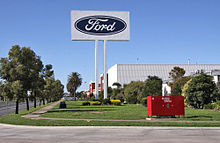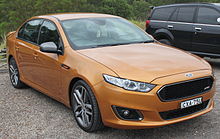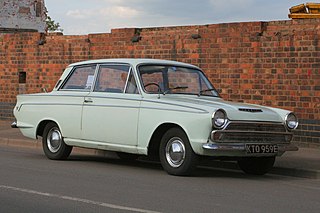
The Ford Cortina is a medium-sized family car manufactured and marketed initially by Ford of Britain, and then Ford of Europe in various body styles from 1962 to 1982 over five generations — and was the United Kingdom's best-selling car of the 1970s.

The Ford Galaxie is a full-sized car that was built in the United States by Ford for model years 1959 through 1974. The name was used for the top models in Ford's full-size range from 1958 until 1961, in a marketing attempt to appeal to the excitement surrounding the Space Race. In 1958, a concept car was introduced called "la Galaxie" which incorporated the headlights into pods inline with the grille and a reduced front profile.

The Ford Telstar is an automobile that was sold by Ford in Asia, Australasia and Africa, comparable in size to the European Ford Sierra and the North American Ford Tempo. It was progressively replaced by the Ford Mondeo. The car was named after the Telstar satellite.

The Ford Falcon is a full-size car that was manufactured by Ford Australia from 1960 to 2016. From the XA series of 1972 onward, each Falcon and range of derivates have been designed, developed, and built in Australia, following the phasing out of the American-influenced Falcon of 1960 to 1971, which had been re-engineered locally as the XK to XY series for the harsher Australian conditions. The luxury-oriented Ford Fairmont model joined the range from 1965. Luxury long-wheelbase derivative versions called the Ford Fairlane and LTD arrived in 1967 and 1973 respectively with production ending in 2007.
The name Ford Corsair was used both for a car produced by Ford of Britain between 1963 and 1970, and for an unrelated Nissan-based automobile marketed by Ford Australia between 1989 and 1992.
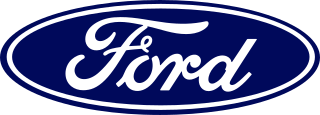
Ford Motor Company of New Zealand Limited is the New Zealand subsidiary of Ford Motor Company. The Ford-New Zealand assembly and distribution began in 1936, following the successful representation of Ford's New Zealand business by The Colonial Motor Company (CMC). Ford-New Zealand was based in Seaview, Wellington. A second assembly plant was opened in Wiri, Auckland in 1973. The head office was moved to Auckland before Seaview was closed in 1988 and, in 1997, vehicle production at Wiri came to an end. Since then, all of the Ford-New Zealand product offerings have been fully imported.

Carrozzeria Ghia SpA is an Italian automobile design and coachbuilding firm, established by Giacinto Ghia and Gariglio as "Carrozzeria Ghia & Gariglio". The headquarters are located at Corso Guglielmo Marconi, 4, Turin. The company is currently owned by Ford Motor Company and focused on the European market through Ford's subsidiary in the region.

The Ford Fairlane is an automobile model that was sold between the 1955 and 1970 model years by Ford in North America. Taking its name from the Dearborn, Michigan estate of Henry Ford, the Fairlane nameplate was used for seven different generations of vehicles. Through its production, the model line would be marketed in a wide variety of body styles, including two-door and four-door sedans, two-door and four-door hardtops, station wagons, and both traditional and retractable-hardtop convertibles.
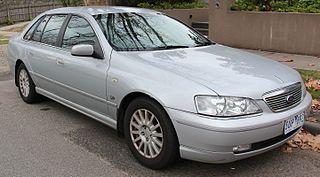
The Ford Fairlane and LTD are full-sized luxury vehicles produced in a series of models by Ford Australia between 1959 and 2007.

Fiat Chrysler Australia, officially FCA Australia, is the official Stellantis subsidiary in that country, operating as distributor of Chrysler, Jeep, Dodge, Abarth, Alfa Romeo and Fiat vehicles. However, there had previously been a "Chrysler Australia Ltd" which had operated as a vehicle manufacturer in Australia from 1951 until 1980, and was subsequently taken over by Mitsubishi Motors Australia.
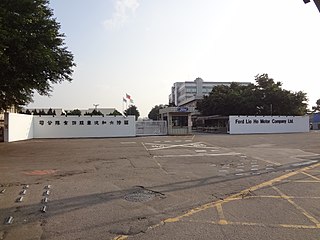
Ford Lio Ho Motor is a Taiwanese-based automaker and the primary dealer of Ford vehicles in Taiwan, formed in 1972. It is 70 percent owned by Ford Motor Company. The remaining 30 per cent is owned by investors in the former Lio Ho Automotive Industrial Corporation, which previously assembled Toyota vehicles.

The Ford Falcon is a model line of cars that was produced by Ford from the 1960 to 1970 model years. Though preceded by the Rambler American, the Falcon was the first compact car marketed by the Big Three American manufacturers.
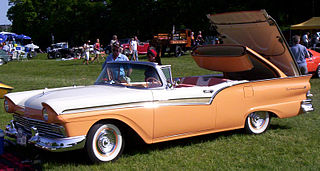
The mainstream Ford line of cars grew substantially larger for 1957, a model which lasted through 1959. The Crown Victoria with its flashy chrome "basket handle" was no more, and the acrylic glass-roofed Crown Victoria Skyliner was replaced by a new model, the retracting-roof hardtop Skyliner.

The Holden was a full-sized car produced by the company of the same name across 5 generations from 1948 until 1984. The Holden is also commonly referred to by their model designation and also the H Series. The Holden was introduced to be Australia's car, being the first full scale produced automobile exclusive to the country. Prior to which, General Motors Holden's Ltd. assembled imported CKD kits from overseas General Motors subsidiaries such as Chevrolet, Buick, Vauxhall and more. And the only other cars built in the country being Ford and Chrysler vehicle bodies fitted to imported chassis. The Holden was an instant success among Australians, being the first production car built solely for Australia's unique, rough roads.
Full-size Ford is a term adopted for a long-running line of Ford vehicles with a shared model lineage in North America. Originating in 1908 with the Ford Model T, the line ended in 2019 with the Ford Taurus, as Ford withdrew from the full-sized sedan segment in North America. Across 111 years, 15 generations, and over 60 million examples of the model line were produced across over 50 model nameplates. By contrast, the longest-running single nameplate worldwide is the Chevrolet Suburban, in use since the 1935 model year.

Statesman is an automotive marque created in 1971 by the Australian General Motors subsidiary, Holden. Statesman vehicles were sold through Holden dealerships, and were initially based on the mainstream Holden HQ station wagon platform, thereby providing more interior room and generally more luxurious features than their Holden-branded sedan siblings. Production ceased with the last of the WB series cars in January 1985.

Ford Argentina S.C.A. is the Argentine subsidiary of Ford Motor Company founded in Buenos Aires in 1913. Its first products were Model Ts assembled from complete knock down (CKD) kits provided by Ford Motor Company in 1917. Nevertheless, Ford Motor Argentina is best known in more recent times for producing the Ford Focus and, previously, the Argentine version of the Ford Falcon, originally a U.S. model introduced in Argentina in 1961, but adapted to the Argentine market.

Ford Motor Company is an American multinational automobile manufacturer headquartered in Dearborn, Michigan, United States. It was founded by Henry Ford and incorporated on June 16, 1903. The company sells automobiles and commercial vehicles under the Ford brand, and luxury cars under its Lincoln brand. Ford also owns a 32% stake in China's Jiangling Motors. It also has joint ventures in China, Taiwan, Thailand, and Turkey. The company is listed on the New York Stock Exchange and is controlled by the Ford family; they have minority ownership but the majority of the voting power.
The Broadmeadows Assembly Plant was a Ford Australia automobile factory in Campbellfield, Melbourne. It spanned 45 acres (18 ha) and as of 2011, employed 2,088 workers. It opened in 1959.

The Ford Mondeo I (first generation) is a mid-size car that was produced by Ford, beginning on 23 November 1992, with sales beginning on 22 March 1993. It is also known as the Mk I Mondeo; the 1996 facelift versions are usually designated Mk II. Available as a four-door saloon, a five-door hatchback, and a five-door estate, all models for the European market were produced at Ford's plant in the Belgian city of Genk. In December 1992, Autocar published a section on the Mondeo, and how it would conquer rivals.



